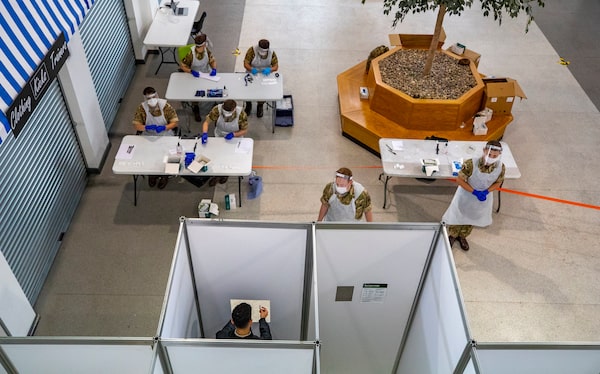
Soldiers carry out mass coronavirus testing, set up at a marketplace in Liverpool, England, during the four-week national lockdown to curb the spread of coronavirus in England, on Nov. 11, 2020.Peter Byrne/The Associated Press
David Juncker is a professor and chair of McGill University’s department of biomedical engineering. Donald Sheppard is professor and chair at McGill’s department of microbiology and immunology, and director of the McGill Interdisciplinary Initiative in Infection and Immunity.
COVID-19 is spreading uncontrollably here in Canada, but there could be a solution that doesn’t involve a lockdown. Canada should use screening testing – mass testing of asymptomatic people – to get the virus under control.
Several universities in the United States, such as the University of Illinois at Urbana-Champaign, Tufts University and Boston University, have implemented regular, convenient screening testing of students and staff twice a week while also upholding other protective measures. As a result, those campuses have emerged as safe havens of low disease prevalence, resisting waves of high infection surrounding them.
Their strategy is centred on quick, easy and convenient testing via self-swabbing (through the nose) or spitting into a tube. Samples are then sent to a laboratory for polymerase chain reaction (PCR) analysis, which replicates the viral genetic material in the sample billions of times and detects it, with results returned in less than 24 hours.
In Canada, COVID-19 testing is primarily focused on symptomatic patients and their immediate contacts. However, because of inadequate capacity and logistics, that testing predictably keeps failing when cases rise and it is needed urgently. The current approach to testing suffers from several limitations: It relies heavily on health professionals, people are often reluctant to get tested and results are often delayed. Together these factors combine to limit the ability of contact tracing to slow spread and break the epidemic cycle.
Could we adopt the approach from the American universities? Screening testing at the national scale (one million weekly tests or more) using PCR remains challenging because of supply bottlenecks and cost (tens of dollars per test), although pooling of samples might help.
Rapid diagnostic tests offer a promising alternative: They provide results in around 15 minutes, can cost as little as 50 cents per test and millions a day can be manufactured. Their sensitivity is lower, but they are adequate to detect the high viral loads correlated with infection, which last just a few days. Frequent testing could thus identify contagious individuals – including asymptomatic ones who are a large source of transmission, but currently fall through the cracks – and cut the chains of infection.
Canada took important early steps and initiatives to understand and manage the pandemic, and established task forces for vaccines, therapies and immunity, but not for diagnosis. Diagnosis falls under the provinces, which in the absence of a coherent national diagnostic strategy, failed to coordinate and anticipate sufficiently, leading to the severity of the current outbreak.
The blind spot for diagnostics could explain the lack of concerted initiatives to develop new diagnostic technologies, the lack of adequate planning for diagnostic capacity and the initial aversion to consider rapid diagnostic tests. To its credit, following delays and public pressure, Health Canada approved several rapid tests, securing millions of them, but those tests remain dependent on a health professional for swabbing and most require an instrument for readout. And while the tests will have an impact, the numbers are insufficient for regular screening tests.
The government has invested upwards of half a billion dollars in Canadian R&D efforts and more in securing supplies for therapeutics and vaccines, including the ones from Pfizer and Moderna that released very encouraging early results from their clinical trials. However, it is far too early to lower our guard against the virus as many caveats remain with the vaccines. Both are new and experimental, and the duration of the protection, whether each covers the elderly and when they will be broadly available remains unknown.
Rising COVID-19 cases are a daily reminder of the urgent need for testing. We must define nationwide screening testing as an essential public health need. We will need a task force on diagnostics and a national mobilization to spur and nurture the development of rapid diagnostic tests and a secured supply chain. We also need plans for logistics, distribution and data collection, guidelines for testing and so on.
There is a unique opportunity to recover lost ground, as well, by developing tests as an open source initiative predicated on sharing techniques and methodologies, and thus benefiting from global expertise while unleashing the power of solidarity. Rapid tests are a mature technology free from intellectual property claims, and can be built using openly sourced materials and reagents. Canada is a pioneer in open science and global health initiatives, and we could thus harness our expertise and network to address national and global testing needs at the same time.
Rapid screening testing could help us return to quasi-normality, while avoiding the extraordinary financial and human costs of a lockdown. We must start with a task force to work out the plan and mobilize resources nationally and globally.
Keep your Opinions sharp and informed. Get the Opinion newsletter. Sign up today.